Pasajera en trance, pasajera en transito perpetuo[1]. Chiara Fumai has been a passenger perpetually in transit between female characters shoved aside by the registered history, between authentically imperfect women in their militant existences or in their proud discomfort. Zalumma Agra, Eusapia Palladino, Annie Jones, Ulrike Meinhof are some of the most beautiful female presences coexisting inside the Margherita Theater of Bari on the occasion of the retrospective dedicated to the artist. An experiential exhibition path well-throught-out as a unique and global installation inspired by the spatial features of the building in Bari.
Talking about Chiara Fumai is like getting closer to a complex paradigm of iconographies and performing practices, dotted with references to different ideological dimensions, from radical feminism to spiritualism, from occultism to literary and philosophical pleadings. Suspended situations between reality and artifice, where paradox and humor noir provide an interpretative direction for those who decide entering inside of them. Describing Chiara’s art is equivalent to narrating an archive of different and interesting episodes endowed with extreme vitality, of several characters-icons of Freak Show, with grotesque forays into the mechanisms of modern and contemporary history, aimed at unmasking the iniquity of ingrained and obsolete thought systems.
Thus, the worlds of collective and shared culture appear in perpetual transit. Intellectual paradigms to deconstruct, decompose and recall, where the presence of the voice-φωνή is message and sound energy, apotropaic and trigger channel in the mise-en-scène of intimate environments in which expected, evoked and greeted characters take shape with their own singular existence and temperament.
Among them, Zalumna Agra, a character belonging to the Barnum Circus evoked by the artist, lives inside the completely darkened initial space of the Margherita Theater. In the video performance “Shut Up Actually Talk” (created for Documenta), Zalumma reads the Secondo Manifesto di Rivolta femminile “Io dico Io” composed by Carla Lonzi during the seventies. Expressing one’s sense of existence, released from any form of subordination, freeing oneself from the social constraints imposed by patriarchal society, were the key points of this movement which also included Carla Accardi and Elvira Banotti. Here, the voice of Chiara / Zalumna expresses, manifests, greed and distorts certainties.
Several different characters of her performances are evoked in the interesting staging of a spirit session. The action is contained in the video installation entitled “The Book of Evil Spirits” (presented at the Contour Biennale in 2016 and winner of the VII edition of the VAF Foundation Award) which is placed on the left side of the foyer. In addition, at the back of the Theater, another magnificent personality shows up from this multifaceted archive, she is “The delinquent woman”, the medium of Apulian origins Eusapia Palladino who, by Chiara, returns insolent in the current dimension.
It is not only voice, but also symbol, sign, perfect shape and circular idea that like an irreverent lunar cycle, fuels an elegant mystification of paradigms and cultural habits. On the floor of the Theater, a large seal with the representation of a seven-pointed star is proposed in the form of installation, a star that is notoriously a symbol of dark power to which, however, the artist adds the motto “pop”: “Follow you this, bitches”, the expression used by the singer Cher during her live concerts.
Thus, artifice and paradox contribute to the construction of a direct syntax for the narration of patriarchal dynamics and socio-cultural processes. Starting from the aesthetic assimilation of characters and situations, arise new agglutinations of formulas and phenomena, in where the primary materials are investigated, disconnected and symbolically recomposed.
The presence of Chiara looks like a rigorous interference, her speeches are impertinent and lasting matter, where the voice reveals, admonishes, ritually placates, but most of all questions in order to lead through maieutic irony to the awareness that art is an active part in life’s comprehension. It is not fear, but a lucid and vital presence that can attenuate the shaded areas, precisely those one that feed on reflected images and collective beliefs that everyone project “where everything is dark, to mitigate the fear they have of the dark”. As Sebastiano Vassalli narrates in his historical-social novel “The Chimera”[2] set in seventeenth-century Piedmont, in a climate of superstitious and intolerant misogyny, in which the protagonist Antonia is accused of witchcraft.
And with reference to the historical processes of the past, Chiara Fumai’s performative actions recall that its events and consequences must be observed, standing in those crucial junctions where artifice and resistance, atavistic memory, reality and dystopia coexist. The result of this action is the documentation of glimmers of truth, of infinitesimal moments of personal history. In this context it is particularly interesting “The Church of Chiara Fumai”, the section that houses the artist’s objects, paintings, posters, records, videos, in which there is also a special focus dedicated to Nicola Fumai, Chiara’s father, who recently passed away.
In the end, Chiara Fumai’s is perhaps an attempt to codify and update the chaos of social liturgies, retracing the primitive traces that in the authoritative sign (sigillum) of what “has been told” find an energetic manifestation, therefore, a potential for archiving, transmission and redemption, or even prediction of what “will happen”. Como dormir y estar despierto[3].
The retrospective dedicated to Chiara Fumai comes from an idea by Anna Fresa and Paola Marino, with the curatorship of Antonella Marino and the scientific advice of Francesco Urbano Ragazzi, director of “The Church of Chiara Fumai”, the association chaired by Liliana Chiari, mother of the artist.
[1] Passenger in trance, passenger in perpetual transit. Those are not the lyrics of a hit, but of a synth-pop song included in the tracklist of the album “Tango” by the Argentinian singer-songwriter and musician Charly Garcia launched in 1986 and recorded with Pedro Aznar in the rooms of the Grammercy Park Hotel in New York during just one week. This is the incipit of this text dedicated to Chiara Fumai, I know she would have liked to know that this song never attempted to be necessarily a hit.
[2] La chimera is a novel by Sebastiano Vassalli published in 1990 and winner of the Strega prize.
[3] How to sleep and stay awake
 “The Church of Chiara Fumai”, ambiente d’archivio, dettagli, 2020. Courtesy of Cosmo Laera
“The Church of Chiara Fumai”, ambiente d’archivio, dettagli, 2020. Courtesy of Cosmo Laera
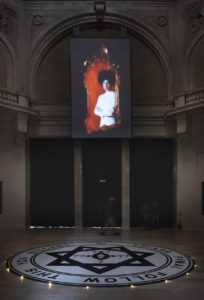 “Shut Up Actually Talk” video e “Follow This You Bitches” sigillo, 2013, Omaggio a Chiara Fumai, Teatro Margherita, 2020. Courtesy of Cosmo Laera
“Shut Up Actually Talk” video e “Follow This You Bitches” sigillo, 2013, Omaggio a Chiara Fumai, Teatro Margherita, 2020. Courtesy of Cosmo Laera
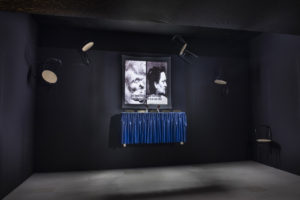 “La Donna Delinquente”, videoinstallazione, 2011-2013. Courtesy of Cosmo Laera
“La Donna Delinquente”, videoinstallazione, 2011-2013. Courtesy of Cosmo Laera
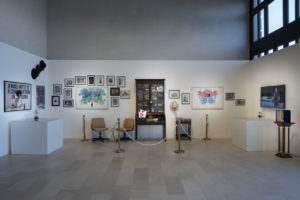 “The Church of Chiara Fumai”, ambiente d’archivio, dettagli, 2020. Courtesy of Cosmo Laera
“The Church of Chiara Fumai”, ambiente d’archivio, dettagli, 2020. Courtesy of Cosmo Laera
Giuliana Schiavone. Art critic and curator based in Italy and Mexico dedicated to the communication and teaching of visual arts. Active contributor to national and international art and fashion magazines as well as promotion of contemporary art. Actively working for cultural and exhibition projects. Graduated as Art Historian and Jazz Musician with a Master in Art Curatorship following an interdisciplinary vision of artistic and aesthetic phenomenons.



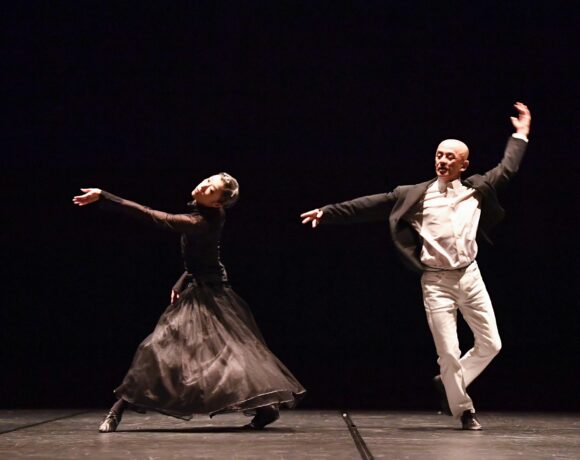
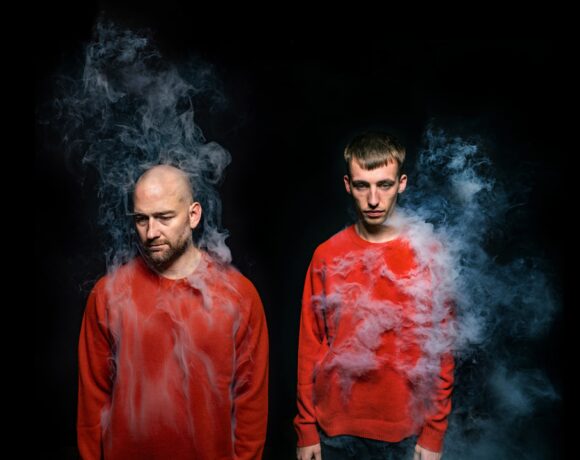

NO COMMENT